
北京化工大学2005一2006学年第一学期 《材料导论》期末考试试卷-A 班级: 姓名: 学号: 分数: 题号 二 三 五 六 七 总分 得分 Choose the BEST TERM to match the definition and translate the selected term into Chinese 20pts) Atomic packing factor (APE) 包 Long-range-order materials B) Characterization Mixture C Coordination number Modulus of resilience DP dulu s of toughness for assembly Design for disassem bly Non-ferrous metals G) Differential thermal analysis X) Optical microscope Electron microscope Proton range-order materials attice L Ferrous metals od fraction M Hardness DD Toughness lonization potential Unit cell ce elec HHY .A concept that places emphasis on designed products that lead themselves to easy assembly by robots and o ther a utomated equipment. A mate tha composition and contains more than one phase.The components )L has no fi A measure f resistance to penetration (local plastic deformation)or scratching 4.A technique produces temperature patterns that can be interpreted to obtain information about the changes that application. A use that is usec to study the crystal structures of solids by measuring the angles of An inst wide of about 2000x and is relatively low-cost. .A measure of the attraction between the electron and the nucleus. 8. he ma ehtoatowrince unit volume that material can absorb without plastic deformation 1.The method used during design and manufacturing to determine the impact of a product or system on the environment. 14.The term implies that a material plastically deforms or flows very slowly under load as a function of time. ferent numbers of neutron 第1而
第 1 页 北京化工大学 2005——2006 学年第一学期 《材料导论 I》期末考试试卷-A 班级: 姓名: 学号: 分数: 题号 一 二 三 四 五 六 七 总分 得分 I. Choose the BEST TERM to match the definition and translate the selected term into Chinese (20pts). A) Atomic packing factor (APF) B) Characterization C) Coordination number D) Creep E) Design for assembly F) Design for disassembly G) Differential thermal analysis H) Electron microscope I) Electron affinity J) Electronegativity K) Electrons L) Ferrous metals M) Hardness N) Ionization potential O) Isotope P) Life Cycle Analysis Q) Life Cycle Inventory R) Long-range-order materials S) Mixture T) Modulus of resilience U) Modulus of toughness V) Neutrons W) Non-ferrous metals X) Optical microscope Y) Proton Z) Short-range-order materials AA) Solution BB) Space lattice CC) Void fraction DD) Toughness EE) Unit cell FF) Valence electrons GG) X-ray diffraction HH) Yield 1. A concept that places emphasis on designed products that lead themselves to easy assembly by robots and other automated equipment. 2. A material that has no fixed composition and contains more than one phase. The components (substances) keep their individual identities. 3. A measure of a material’s resistance to penetration (local plastic deformation) or scratching. 4. A technique produces temperature patterns that can be interpreted to obtain information about the various structural changes that solids undergo as a result of the application of different external forces. 5. A useful tool that is used to study the crystal structures of solids by measuring the angles of electrons glancing off material specimens. 6. An instrument provides magnification of about 2000× and is relatively low-cost. 7. A measure of the attraction between the electron and the nucleus. 8. The energy required to remove a valence electron from an atom. 9. The materials have the structures in which the order of atoms is limited to an atom’s nearest neighboring atoms. 10. A measure of the energy per unit volume that material can absorb without plastic deformation. 11.The method used during design and manufacturing to determine the impact of a product or system on the environment. 12.The ratio of the volume of atoms present in a crystal (unit cell) to the volume of the unit cell. 13.The small particles that occupy the outmost ring or shell from the nucleus, and control the chemical properties of an element. 14.The term implies that a material plastically deforms or flows very slowly under load as a function of time. 15.The term is described by saying that atoms of an element that contain the same number of protons, but different numbers of neutrons
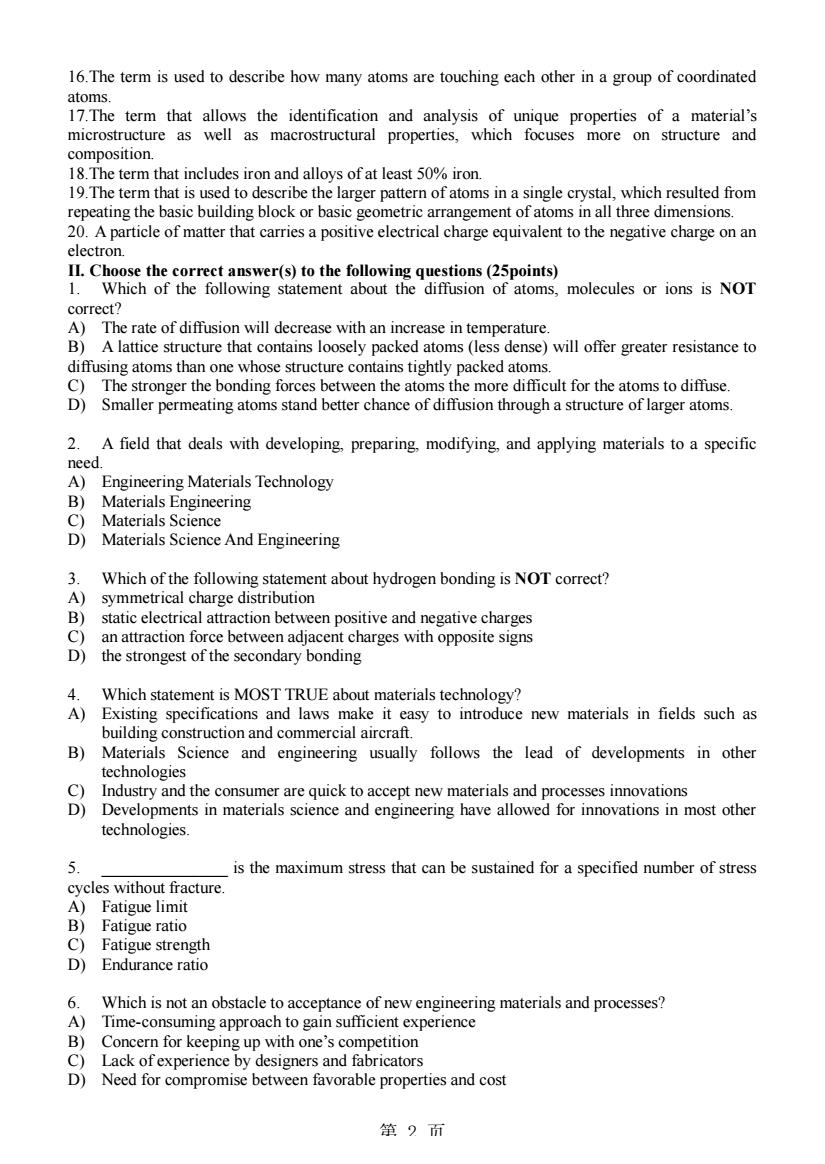
16.The term is used to describe how many atoms are touching each other in a group of coordinated and analysis term thaalrructural propertes. microstructure as well of a material' more on structure and 18 The te of at least 50%ir 19.The te hat includesiron an n that is d t repeating the basic vstal.which resulted from nsions electron IL.Choose the correct answer(s)to the followin estions (25points) 1.Which of the following statement about the diffusion of atoms,molecules or ions is NOT correct? A)The rate of diffusion will decrease with an increase in temperature. B) A lattice structure that contains loosely packed atoms(less dense)will offer greater resistance to diffusing atoms than one whose structure contains tightly packed atoms. The stronger the bonding forces between the atoms the more difficult for the atoms to diffuse. D) Smaller permeating atoms stand better chance of diffusion through a structure of larger atoms 2. A field that deals with developing.preparing.modifying.and applying materials to a specific ng Materials Technology Mate Engineering e And Engincering Which of the followin statement about hydrogen bonding is NOT correct? A)sv metrical charge distrib on static electrical at ction be an attraction force bet en positive and negative char s with site D)the strongest of the secondary bonding 4 Which statement is MOST TRUE about materials technology? A)Existing specifications and laws make it easy to introduce new materials in fields such as building construction and commercial aircraft. B)Materials Science and engineering usually follows the lead of developments in other technologies Industry and the consumer are quick to accept new materials and processes innovations D) Devel opments in materials science and engineering have allowed for innovations in most other technologies. 5. is the maximum stress that can be sustained for a specified number of stress D)Endur nce ratio 6 Which is not an obstacle to acceptance of new engineering materials and processes? A)Time-consuming approach to gain sufficient experience B)Concern for keeping up with one's competition C)Lack of experience by designers and fabricators D)Need for compromise between favorable properties and cost 箱9而
第 2 页 16.The term is used to describe how many atoms are touching each other in a group of coordinated atoms. 17.The term that allows the identification and analysis of unique properties of a material’s microstructure as well as macrostructural properties, which focuses more on structure and composition. 18.The term that includes iron and alloys of at least 50% iron. 19.The term that is used to describe the larger pattern of atoms in a single crystal, which resulted from repeating the basic building block or basic geometric arrangement of atoms in all three dimensions. 20. A particle of matter that carries a positive electrical charge equivalent to the negative charge on an electron. II. Choose the correct answer(s) to the following questions (25points) 1. Which of the following statement about the diffusion of atoms, molecules or ions is NOT correct? A) The rate of diffusion will decrease with an increase in temperature. B) A lattice structure that contains loosely packed atoms (less dense) will offer greater resistance to diffusing atoms than one whose structure contains tightly packed atoms. C) The stronger the bonding forces between the atoms the more difficult for the atoms to diffuse. D) Smaller permeating atoms stand better chance of diffusion through a structure of larger atoms. 2. A field that deals with developing, preparing, modifying, and applying materials to a specific need. A) Engineering Materials Technology B) Materials Engineering C) Materials Science D) Materials Science And Engineering 3. Which of the following statement about hydrogen bonding is NOT correct? A) symmetrical charge distribution B) static electrical attraction between positive and negative charges C) an attraction force between adjacent charges with opposite signs D) the strongest of the secondary bonding 4. Which statement is MOST TRUE about materials technology? A) Existing specifications and laws make it easy to introduce new materials in fields such as building construction and commercial aircraft. B) Materials Science and engineering usually follows the lead of developments in other technologies C) Industry and the consumer are quick to accept new materials and processes innovations D) Developments in materials science and engineering have allowed for innovations in most other technologies. 5. _______________ is the maximum stress that can be sustained for a specified number of stress cycles without fracture. A) Fatigue limit B) Fatigue ratio C) Fatigue strength D) Endurance ratio 6. Which is not an obstacle to acceptance of new engineering materials and processes? A) Time-consuming approach to gain sufficient experience B) Concern for keeping up with one’s competition C) Lack of experience by designers and fabricators D) Need for compromise between favorable properties and cost
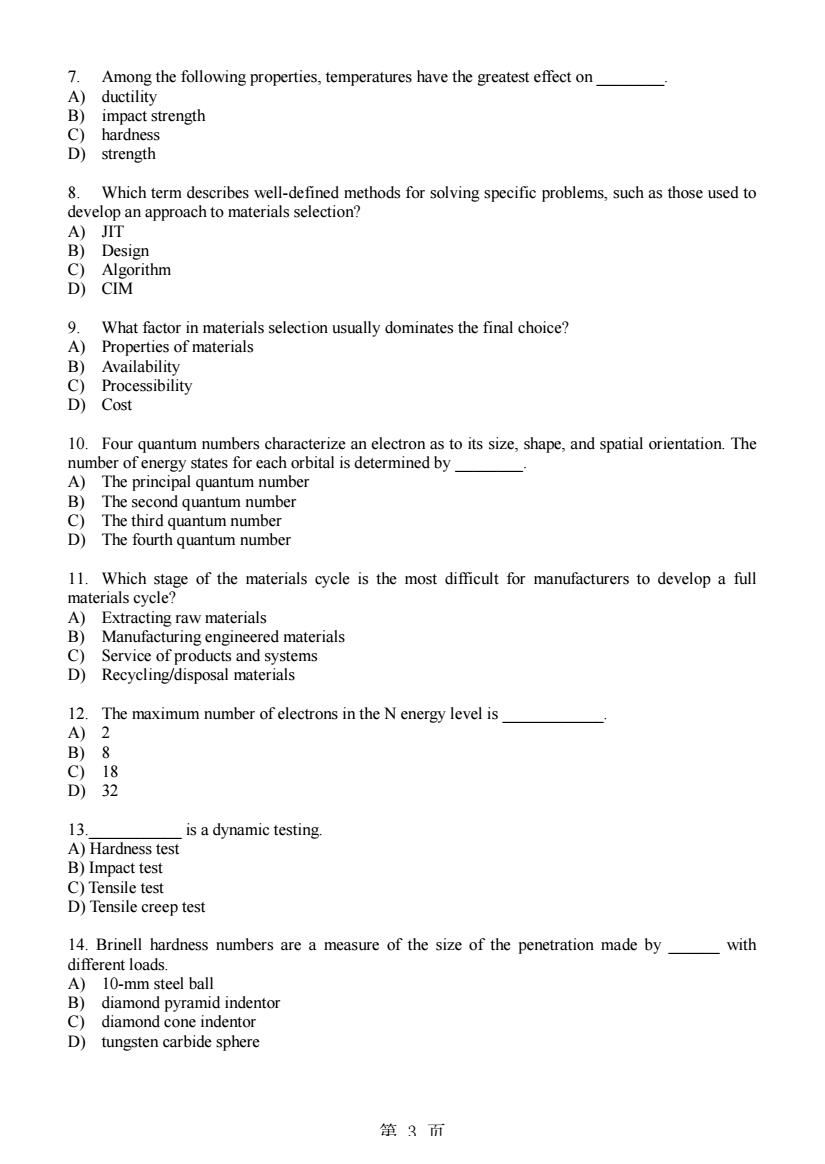
7.Among the following properties,temperatures have the greatest effect on A)ductility B)impact strength hardness D)strength 8 Which term describes well-defined methods for solving specific problems,such as those used to develop an approach to materials selection? A) D sign CIM thm 0 Wsction usul dointhechoice A)P B) C)Processibility D)Cost 10.Four quantum numbers characterize an electron as to its size.shape,and spatial orientation.The number of energy states for each orbital is determined by A)The principal quantum number B)The second quantum number C)The third quantum number D)The fourth quantum number 11.Which stage of the materials cycle is the most difficult for manufacturers to develop a full materials cycle? Extracting raw materials Manutacturing engineered materials D) of prod d sys Recycling/dispos materla 12.The maximum number of electrons in the N energy level is A)2 B)8 C18 D)32 6 is a dynamic testing A)Hardness test B)Impacttest C)Tensile test D)Tensile creep test 14.Brinell hardness numbers are a measure of the size of the penetration made by with different loads 10-mm steel bal amon pyramid inden D d cone inder tungsten carbide sphere 第3而
第 3 页 7. Among the following properties, temperatures have the greatest effect on ________. A) ductility B) impact strength C) hardness D) strength 8. Which term describes well-defined methods for solving specific problems, such as those used to develop an approach to materials selection? A) JIT B) Design C) Algorithm D) CIM 9. What factor in materials selection usually dominates the final choice? A) Properties of materials B) Availability C) Processibility D) Cost 10. Four quantum numbers characterize an electron as to its size, shape, and spatial orientation. The number of energy states for each orbital is determined by ________. A) The principal quantum number B) The second quantum number C) The third quantum number D) The fourth quantum number 11. Which stage of the materials cycle is the most difficult for manufacturers to develop a full materials cycle? A) Extracting raw materials B) Manufacturing engineered materials C) Service of products and systems D) Recycling/disposal materials 12. The maximum number of electrons in the N energy level is ____________. A) 2 B) 8 C) 18 D) 32 13.___________ is a dynamic testing. A) Hardness test B) Impact test C) Tensile test D) Tensile creep test 14. Brinell hardness numbers are a measure of the size of the penetration made by ______ with different loads. A) 10-mm steel ball B) diamond pyramid indentor C) diamond cone indentor D) tungsten carbide sphere
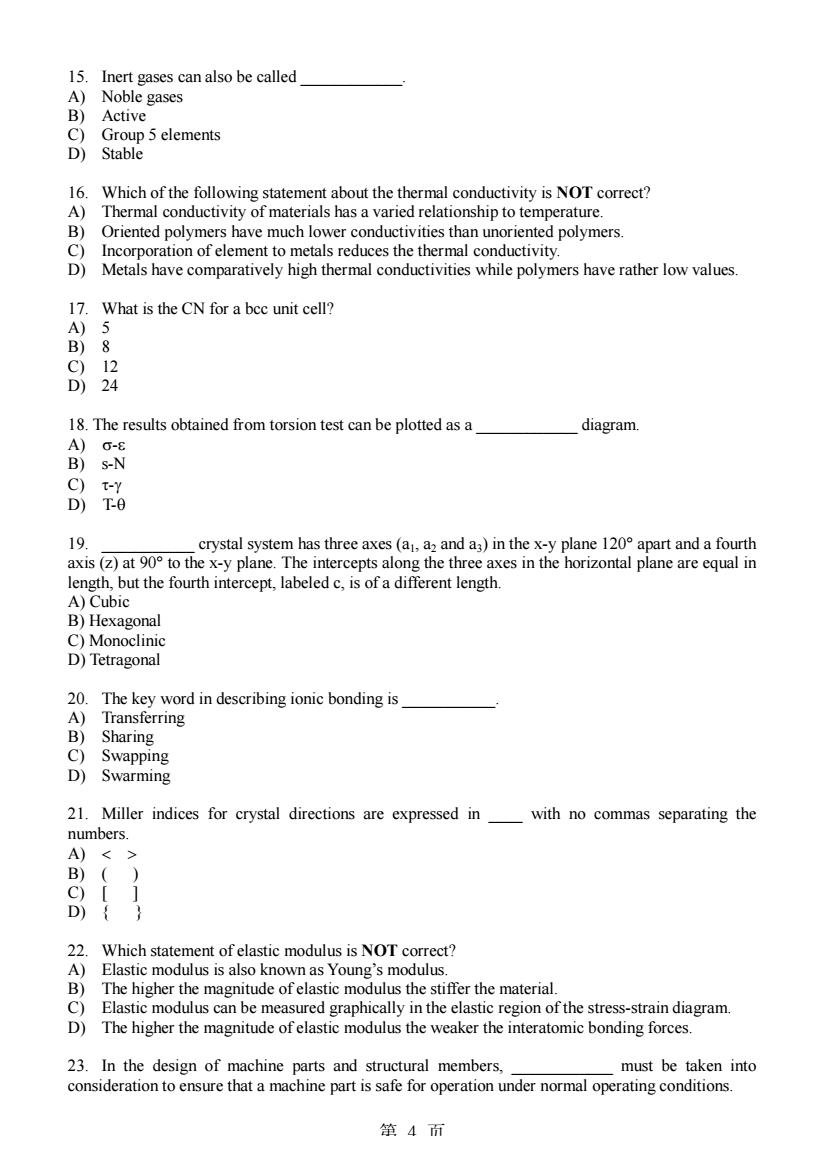
15. B) C) D) Which statement of elastic modulus is NOT correct? A) Elastic modulus is also known as Young's modulus. B The higher the magnitude of elastic modulus the stiffer the material. Elastic modulus can be measured graphically in the elastic region of the stress-strain diagram. D) The higher the magnitude ofelastic modulus the weaker the interatomic bonding forces. 23.In the design of machine must be taken into sonsideration to ensure thatmchine oeraton under normal operaing conditions 第4而
第 4 页 15. Inert gases can also be called ____________. A) Noble gases B) Active C) Group 5 elements D) Stable 16. Which of the following statement about the thermal conductivity is NOT correct? A) Thermal conductivity of materials has a varied relationship to temperature. B) Oriented polymers have much lower conductivities than unoriented polymers. C) Incorporation of element to metals reduces the thermal conductivity. D) Metals have comparatively high thermal conductivities while polymers have rather low values. 17. What is the CN for a bcc unit cell? A) 5 B) 8 C) 12 D) 24 18. The results obtained from torsion test can be plotted as a ____________ diagram. A) s-e B) s-N C) t-g D) T-q 19. ___________ crystal system has three axes (a1, a2 and a3) in the x-y plane 120° apart and a fourth axis (z) at 90° to the x-y plane. The intercepts along the three axes in the horizontal plane are equal in length, but the fourth intercept, labeled c, is of a different length. A) Cubic B) Hexagonal C) Monoclinic D) Tetragonal 20. The key word in describing ionic bonding is ___________. A) Transferring B) Sharing C) Swapping D) Swarming 21. Miller indices for crystal directions are expressed in ____ with no commas separating the numbers. A) B) ( ) C) [ ] D) { } 22. Which statement of elastic modulus is NOT correct? A) Elastic modulus is also known as Young’s modulus. B) The higher the magnitude of elastic modulus the stiffer the material. C) Elastic modulus can be measured graphically in the elastic region of the stress-strain diagram. D) The higher the magnitude of elastic modulus the weaker the interatomic bonding forces. 23. In the design of machine parts and structural members, ____________ must be taken into consideration to ensure that a machine part is safe for operation under normal operating conditions
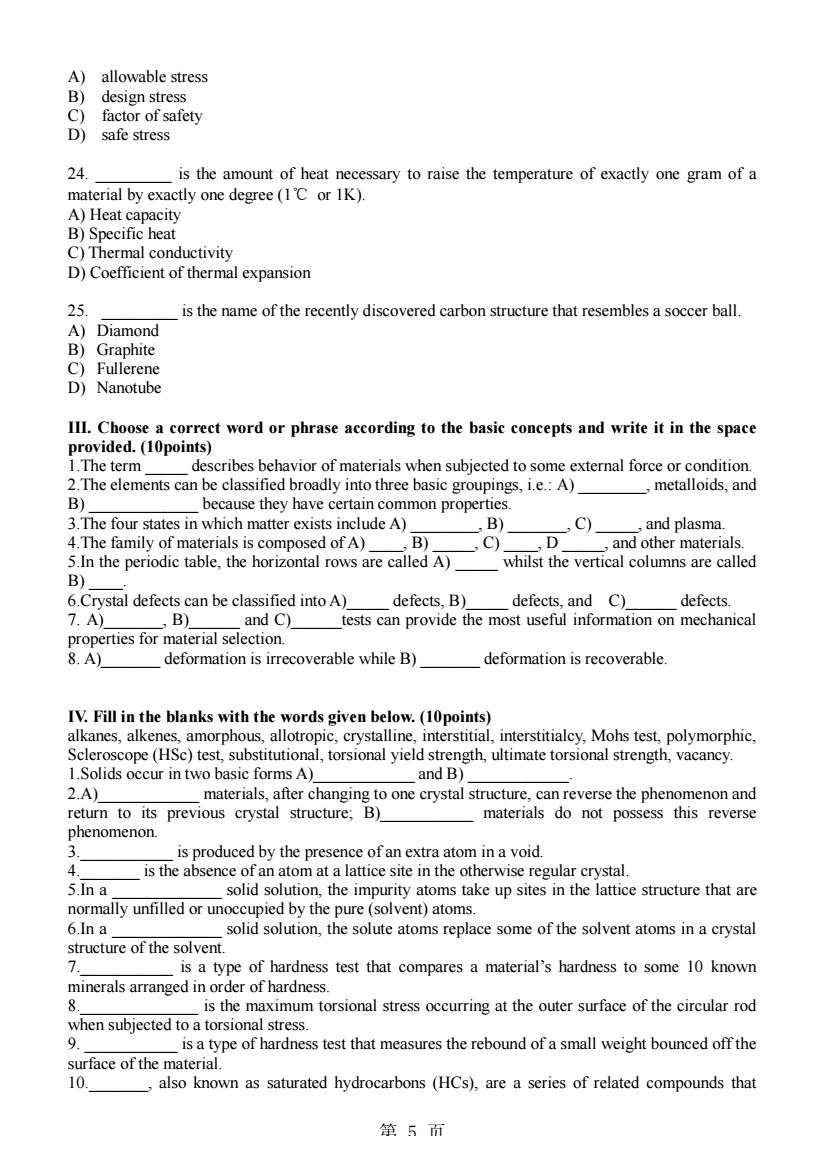
A)allowable stress B)design stress C)factor of safety D)safe stress 24 is the amount of heat necessary to raise the temperature of exactly one gram of a material by exactly one degree(1C or 1K). A)Heat capacity B)Specific heat C)Thermal conductivity D)Coefficient of thermal expansion 25. is the name of the recently discovered carbon structure that resembles a soccer ball. IIL.Choo a correct word or phrase according to the basic concepts and write it in the space ribes behavior of materials when subiected to some external force or condition 2.The eler ments can be classified br adly into three basic gr gs,ie.:A metalloids,and B use they have certai ncommon properties 3.The four states in which matter exists include A) B) C) and plasma 4.The family of materials is composed of A) B) C) D and other materials 5.In the periodic table,the horizontal rows are called A) whilst the vertical columns are called B) 6.Crystal defects can be classified into A) defects,B) defects,and C) defects. 7.A) B) and C) tests can provide the most useful information on mechanical properties for material selection. 8.A) deformation is irrecoverable while B) deformation is recoverable IV.Fill in the blanks with the words given below.(10points) anes,aike us,allotro interstitialcy,Mohs test,polymorphic cope (HS c,cryst su torsio al yield st 01 reverse the phen nenon and to its previous crystal structure; do tpossess this reverse non oduced h th ceof an e n a void is the al at a lattice site in the herwise 5.In a thetyakestre thate normally unfilled or unoccupied by the pure(solvent)atoms. 6.In a solid solution,the solute atoms replace some of the solvent atoms in a crystal structure of the solvent. is a type of hardness test that compares a material's hardness to some 10 known minerals arranged in order of hardness. is the maximum torsional stress occurring at the outer surface of the circular rod when subjected to a torsional stress. ace of the is a type of hardness test that measures the rebound of a small weight bounced off the also known as saturated hydrocarbons (HCs),are a series of related compounds that 第5而
第 5 页 A) allowable stress B) design stress C) factor of safety D) safe stress 24. _________ is the amount of heat necessary to raise the temperature of exactly one gram of a material by exactly one degree (1℃ or 1K). A) Heat capacity B) Specific heat C) Thermal conductivity D) Coefficient of thermal expansion 25. _________ is the name of the recently discovered carbon structure that resembles a soccer ball. A) Diamond B) Graphite C) Fullerene D) Nanotube III. Choose a correct word or phrase according to the basic concepts and write it in the space provided. (10points) 1.The term _____ describes behavior of materials when subjected to some external force or condition. 2.The elements can be classified broadly into three basic groupings, i.e.: A) ________, metalloids, and B) _____________ because they have certain common properties. 3.The four states in which matter exists include A) ________, B) _______, C) _____, and plasma. 4.The family of materials is composed of A) ____, B) _____, C) ____, D _____, and other materials. 5.In the periodic table, the horizontal rows are called A) _____ whilst the vertical columns are called B) ____. 6.Crystal defects can be classified into A)_____ defects, B)_____ defects, and C)______ defects. 7. A)_______, B)______ and C)______tests can provide the most useful information on mechanical properties for material selection. 8. A)_______ deformation is irrecoverable while B) _______ deformation is recoverable. IV. Fill in the blanks with the words given below. (10points) alkanes, alkenes, amorphous, allotropic, crystalline, interstitial, interstitialcy, Mohs test, polymorphic, Scleroscope (HSc) test, substitutional, torsional yield strength, ultimate torsional strength, vacancy. 1.Solids occur in two basic forms A)____________ and B) ____________. 2.A)____________ materials, after changing to one crystal structure, can reverse the phenomenon and return to its previous crystal structure; B)___________ materials do not possess this reverse phenomenon. 3.___________ is produced by the presence of an extra atom in a void. 4._______ is the absence of an atom at a lattice site in the otherwise regular crystal. 5.In a _____________ solid solution, the impurity atoms take up sites in the lattice structure that are normally unfilled or unoccupied by the pure (solvent) atoms. 6.In a _____________ solid solution, the solute atoms replace some of the solvent atoms in a crystal structure of the solvent. 7.___________ is a type of hardness test that compares a material’s hardness to some 10 known minerals arranged in order of hardness. 8.______________ is the maximum torsional stress occurring at the outer surface of the circular rod when subjected to a torsional stress. 9. ___________ is a type of hardness test that measures the rebound of a small weight bounced off the surface of the material. 10._______, also known as saturated hydrocarbons (HCs), are a series of related compounds that
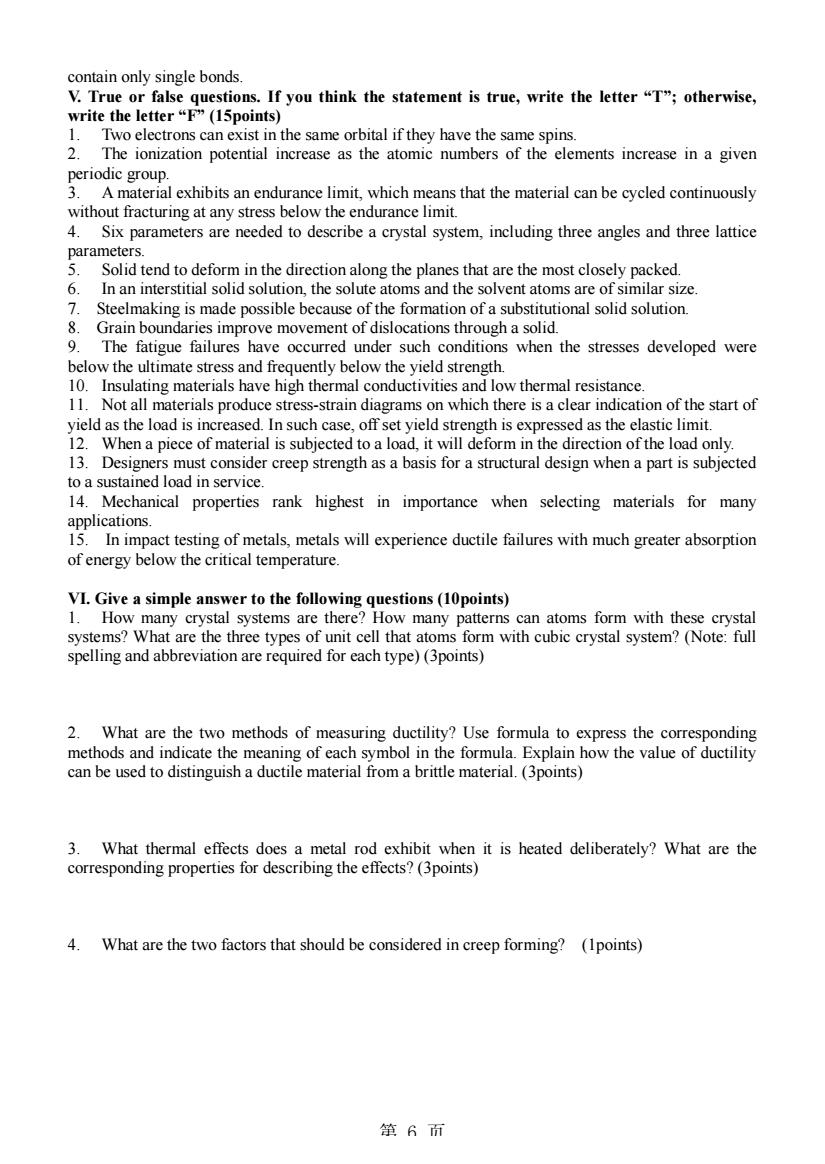
If you think the statement is true,write the letter "T";otherwise, write ncrease as the atomic elements increase in a given ial exhibits an endur ce limit which m ns that the material can be cycled continuously without fracturing at any stress below the endurance limit. 4.Six parameters are needed to describe a crystal system,including three angles and three lattice ram Solid tend to deform in the direction along the planes that are the most closely packed. In an interstitial solid solution,the solute atoms and the solvent atoms are of similar size. > Steelmaking is made possible because of the formation of a substitutional solid solution. Grain boundaries improve movement of dislocations through a solid. 9 The fatigue failures have occurred under such conditions when the stresses developed were below the ultimate stress and frequently below the yield strength. 10.Insulating materials have high thermal conductivities and low thermal resistance. 11. Not all materials produce stress-strain diagrams on which there is a clear indication of the start of yicd th oisncrasd nsucseset yield strength isexpreeas the stic limit. nen a piece or mate al is subjected to a load,it will deform in on of the load only. 13. 14.M m ser anical properties rank highest in importance when selecting materials for many etals will experience ductile failures with much greater absorption of energy b e critical temperature to the followin stal s stems are ther an systems?What are the three types of unit cell that aton spelling and abbreviation are required for each type)(3points) 2.What are the two methods of measuring ductility?Use formula to express the corresponding methods and indicate the meaning of each symbol in the formula.Explain how the value of ductility can be used to distinguish a ductile material from a brittle material.(3points) 3. when it is heated deliberately?What are the What are the two factors that should be considered in creep forming?(lpoints) 策6而
第 6 页 contain only single bonds. V. True or false questions. If you think the statement is true, write the letter “T”; otherwise, write the letter “F” (15points) 1. Two electrons can exist in the same orbital if they have the same spins. 2. The ionization potential increase as the atomic numbers of the elements increase in a given periodic group. 3. A material exhibits an endurance limit, which means that the material can be cycled continuously without fracturing at any stress below the endurance limit. 4. Six parameters are needed to describe a crystal system, including three angles and three lattice parameters. 5. Solid tend to deform in the direction along the planes that are the most closely packed. 6. In an interstitial solid solution, the solute atoms and the solvent atoms are of similar size. 7. Steelmaking is made possible because of the formation of a substitutional solid solution. 8. Grain boundaries improve movement of dislocations through a solid. 9. The fatigue failures have occurred under such conditions when the stresses developed were below the ultimate stress and frequently below the yield strength. 10. Insulating materials have high thermal conductivities and low thermal resistance. 11. Not all materials produce stress-strain diagrams on which there is a clear indication of the start of yield as the load is increased. In such case, off set yield strength is expressed as the elastic limit. 12. When a piece of material is subjected to a load, it will deform in the direction of the load only. 13. Designers must consider creep strength as a basis for a structural design when a part is subjected to a sustained load in service. 14. Mechanical properties rank highest in importance when selecting materials for many applications. 15. In impact testing of metals, metals will experience ductile failures with much greater absorption of energy below the critical temperature. VI. Give a simple answer to the following questions (10points) 1. How many crystal systems are there? How many patterns can atoms form with these crystal systems? What are the three types of unit cell that atoms form with cubic crystal system? (Note: full spelling and abbreviation are required for each type) (3points) 2. What are the two methods of measuring ductility? Use formula to express the corresponding methods and indicate the meaning of each symbol in the formula. Explain how the value of ductility can be used to distinguish a ductile material from a brittle material. (3points) 3. What thermal effects does a metal rod exhibit when it is heated deliberately? What are the corresponding properties for describing the effects? (3points) 4. What are the two factors that should be considered in creep forming? (1points)

are al ansion of ceramics,.metals and polymers using the symbol“n. For eva mpe The hardness of ceramics is greater than metals.Thus,the comparison is expressedas ceramics>metals.(2pts) Thermal expansion:A) From the above comparison,B) have the lowest CTE and C) have the weakest bonding forces among the aforementioned materials. 2.Determine the miller indices of the crystal direction for the line passing through point A with coordinates 2/3.1,0 and the origin of the unit cell shown in Figure 1(4pts) c=1 /B:000 a=1 A b=123,1,0 Fig 1Acubic unit cell 3.Figure 2 is a stress-strain diagram.1)Label A)tensile strength,B)yield strength,C)plastic region,D)elastic region,E)Modulus of elasticity,2)Is this stress-strain diagram for a ductile material or a brittle material?Give two reasons to support your answer.(4 points) Fig 2 A stress-strain diagram 第7而
第 7 页 VII. Complex questions. (10points) 1. Compare the thermal expansion of ceramics, metals and polymers using the symbol “”. For example: The hardness of ceramics is greater than metals. Thus, the comparison is expressed as ceramics > metals. (2pts) Thermal expansion: A) From the above comparison, B)______________ have the lowest CTE and C)____________ have the weakest bonding forces among the aforementioned materials. 2. Determine the miller indices of the crystal direction for the line passing through point A with coordinates 2/3, 1, 0 and the origin of the unit cell shown in Figure 1 (4pts) Fig. 1 A cubic unit cell 3. Figure 2 is a stress-strain diagram. 1) Label A) tensile strength, B) yield strength, C) plastic region, D) elastic region, E) Modulus of elasticity; 2) Is this stress-strain diagram for a ductile material or a brittle material? Give two reasons to support your answer. (4 points) Fig. 2 A stress-strain diagram x z y c=1 b=1 B: 0, 0, 0 a=1 2/3, 1, 0 A x z y c=1 b=1 B: 0, 0, 0 a=1 2/3, 1, 0 A